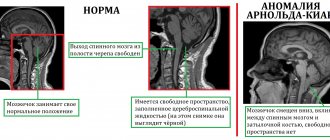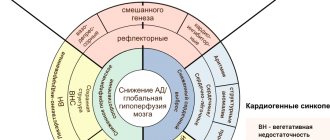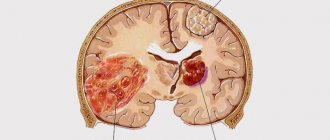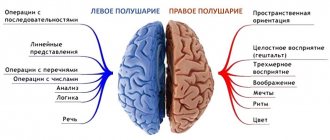| Cachexia | |
| ICD-11 | MG20 |
| ICD-10 | 64. |
| ICD-9 | 799.4799.4 |
| MeSH | D002100 |
| Media files on Wikimedia Commons | |
Cachexia
(ancient Greek κακός - bad, ἕξις - condition;
obsolete "thinness"
[1]) [2] is extreme exhaustion of the body, which is characterized by general weakness, a sharp decrease in weight, activity of physiological processes, as well as changes in mental the condition of a patient who is not actively trying to lose weight. Cachexia physically weakens patients to a state of immobility associated with loss of appetite, asthenia, and anemia, and the response to standard treatment of the underlying disease is usually poor.[3]
Etiology[ | ]
- Sheehan syndrome
- Esophageal stenosis, which makes it difficult for food to enter the stomach;
- Diseases of the gastrointestinal tract (GIT), accompanied by symptoms of impaired digestion and absorption of food, including chronic enterocolitis, celiac disease - sprue, condition after gastrectomy, etc.;
- Psychogenic anorexia;
- Long-term use of psychostimulants
- Amyloidosis;
- Debilitating diffuse connective tissue diseases;
- Long-term intoxication in chronic infectious diseases (brucellosis, tuberculosis, etc.) and purulent processes (abscesses, osteomyelitis);
- Acantholytic pemphigus;
- Severe heart failure;
- Malignant tumors (oncological, in particular, cancer cachexia);
- Metabolic and energy disorders in endocrine diseases, especially in panhypopituitarism (hypothalamic-pituitary insufficiency);
- Adrenal insufficiency;
- Thyroid gland insufficiency;
- Acquired immune deficiency syndrome[4].
Diagnosis and treatment of exhaustion
In case of sudden weight loss and the presence of symptoms that indicate exhaustion of the body, you should immediately contact a specialist to identify the causes of this phenomenon and prescribe a course of treatment and recovery. If the person is severely malnourished, then the person is admitted to the hospital.
To diagnose and treat exhaustion of the body, the following diagnostic and therapeutic measures are carried out:
Conducting a full medical examination
The doctor examines the patient and conducts a full diagnosis to identify the presence or absence of diseases that can trigger greater weight loss again. These are diabetes, the presence of a large amount of thyroid hormones in the blood, lung disease, inflammation in the small intestine, etc.
Prescribing a course of treatment
Treatment for wasting depends on the cause and extent of the disease. All this should be determined by an experienced doctor. If this is the primary form, then the patient first of all needs to eat well and correctly. In order for protein to be well absorbed in the body and weight to be gained gradually, you need to add dietary concentrates and medications according to a treatment regimen developed by a specialist. These are drugs such as: various vitamins, anabolic hormones, adaptogens, etc., they will be described below.
Balanced diet
Treatment of exhaustion primarily involves a proper diet. You need to eat foods with high energy value, foods rich in protein and light carbohydrates, but the fats in your diet should be slightly reduced. To avoid vitamin deficiency, their intake should be significantly increased. Let's consider the principles of a diet for exhaustion of the body:
- You need to increase your energy value by no less than 5 kcal per kilogram of weight. So, for example, with little physical activity, you need to consume not 35, but 40 kcal per 1 kg of weight. For the male half, the energy value of food per day should be at least 2800 kcal, if it is a supine mode, then at least 2400 kcal. When your weight returns to normal, you can already eat foods with normal energy content.
- The increase in the amount of foods containing protein should be up to 1.6 g per kilogram of weight. This is up to about 110 gr. per day, more than 60% should be dairy products, meat, fish, chicken eggs. However, you should not exaggerate the amount of protein either. You can eat the following dishes: egg white omelette; liver pate; boiled fish; eggs are more liquid; chopped boiled meat, you can use it to make quenelles, meatballs, cutlets; chicken or rabbit, stewed or boiled.
- Increasing the amount of fat to 0.7-0.8 g per kilogram of weight, this is approximately 60 g per day. Fats are found in butter, cream, sour cream and fermented milk products with a small percentage of fat content, sunflower oil, fatty varieties of sea fish containing omega 3, and soft margarines. But the consumption of lamb and beef should be slightly reduced, margarine, fats used in cooking and hydro fats should be removed from the diet.
- Increasing the amount of carbohydrates to 6 grams. per kilogram of weight, this is approximately 450 grams per day. It can be various fruits, berries, vegetables, honey, chocolate, jam, bread made from wholemeal flour or sprouted grain. However, you can eat semolina, rice, white flour bread, granulated sugar, but in small quantities. If there are problems with the functioning of the stomach and intestines and food is poorly processed, then you need to remove all products that are related to whole grains.
- Increasing the amount of vitamins from group A, C, E, beta-carotene and minerals (potassium selenium, zinc, manganese, calcium, copper, iron, magnesium). You can use vitamin complexes, which include all of the above elements.
- Dietary concentrates contain a small amount of nutrients needed by a person and serve as a supplement to the main meal. These are drugs such as: Peptamen, Berlamin-modular, Berlamin, Complit, Nutrizon, Nutridrink, Diet Extra, Nutren, etc.
- Infant powder formulas can be used if dietary concentrates are too expensive or are not commercially available. These are Semilak, Novolakt, Nutrilak, Russian-made Malysh (Istra), Prenutrilon. Such mixtures contain emulsified fats and are absorbed by many people better than plain milk and products made from it. When using them, the patient does not often experience diarrhea and diarrhea. They are very easy to prepare; you just need to add boiled warm water. It can be added to dishes, thereby increasing the energy value for nutrition of patients with more severe forms of the disease.
- Canned baby food may also work. They contain higher quality products and are already pureed. These are various vegetable, berry and fruit purees, with cream and cereals. It is also possible to consume children's canned meat and fish in parallel with vegetables.
- Thermal processing of food should be carried out with a more gentle regime for the stomach and intestines, which is mechanical in nature, as well as not strongly stimulating the work of the glands involved in the food digestion system, this in case there are no other strict indications from the food digestion system. It’s good to temporarily remove all foods that are poorly and take a long time to digest. These are mushrooms, legumes, smoked products, all types of fatty meats, thick-skinned fruits and vegetables, etc.
Medicines
Treatment of exhaustion, especially severe forms, may be accompanied by taking various medications. They are prescribed by a doctor. Depending on the cause and form of exhaustion, treatment may include taking the following medications:
- hormonal drugs - Methandrostenolone, Methylandrostenediol, Methandriol or Methandienone;
- adaptogens - Ginseng, Nooclerin, Citrulline malate, Stimol, Mildronate, Deanol aceglumate, Levocarnitine, Elcar, Cropanol or Ginsana;
- combination drugs - Supradin, Centrum, Vitrum plus, Oligovit Alvitil, Upsavit multivitamin, Gerimax, Complivit, Duovit.
Symptoms[ | ]
Symptoms of cachexia include severe weakness, loss of ability to work, and sudden weight loss, often accompanied by signs of dehydration. Weight loss can reach 50% or more.
Subcutaneous tissue decreases sharply or disappears completely, and there are signs of hypovitaminosis (vitamin deficiency). As a result, the skin of patients becomes flabby, wrinkled, turns pale or acquires an earthy-gray tint.
Trophic changes in hair and nails are also present, stomatitis may develop, and severe constipation is typical.
In patients, sexual function decreases; in women, amenorrhea may occur, as the patient’s circulating blood volume decreases.
Glomerular filtration in the kidneys often decreases. Hypoproteinemia, hypoalbuminemia, as well as iron anemia or B12-deficiency anemia are manifested.
Mental disorders are often observed with cachexia. At the beginning of its development, asthenia appears, which causes irritable weakness, tearfulness, and subdepressive mood. With the development of cachexia and asthenia, the adynamic component begins to manifest itself to a greater extent. During exacerbations of the underlying disease, which caused cachexia, clouding of consciousness in the form of amentia, twilight stupefaction, severe or rudimentary forms of delirium, which are replaced by anxious and melancholy states, apathetic stupor, and pseudoparalytic syndrome, may often occur. Despite the favorable outcome of the underlying disease that caused cachexia, prolonged asthenia always remains. In some cases, it is combined with manifestations of psychoorganic syndrome of varying intensity.
Symptoms of body exhaustion
Let's consider how exhaustion of the body manifests itself depending on the degree.
Mild degree of exhaustion
Symptoms of mild exhaustion:
- slight weight loss, weakness throughout the body, faster physical and emotional fatigue, increased sensitivity to lower ambient temperatures, and the patient’s state of detachment from everything;
- not saturating the body with food and a frequent desire to eat something, drink more water, stool retention appears, thinning of muscle tissue, a decrease in its contractility, the lower limbs swell;
- if the patient continues to eat very little, then a second form of exhaustion appears, here the lack of body weight increases to 30% and the body mass index is in the range of 16.0-18.5.
Moderate degree of exhaustion
Symptoms of moderate exhaustion:
- significant thinning of muscle tissue, weakness in all muscles, a significant decrease in performance, severe dizziness, legs and arms may lose sensitivity and become numb, the patient begins to often run to the toilet “in small ways”;
- the face becomes very thin, there are many wrinkles on it, which makes it look old.
Severe exhaustion
Symptoms of severe malnutrition:
- the presence of severe pain in all muscles, the back area, there may be spasms and convulsions in the limbs, there is no appetite at all, strong indifference to everything that happens around, the patient is not embarrassed by his appearance, he experiences frequent mental stress and breakdowns;
- the patient cannot walk on his own, full capacity for work is lost;
- the complexion becomes pale and acquires a yellow-gray color, the skin becomes drier, sagging, has many wrinkles and folds, is very flaky, the sweat glands almost do not function and do not produce sweat;
- the presence of swelling or, on the contrary, the face looks very thin, sharp, the eyeballs sink inward, and the skin sticks to the skeleton.
Treatment varies from patient to patient and involves improving diet and addressing the underlying cause.
Treatment[ | ]
Treatment of patients with cachexia is aimed primarily at the underlying disease, but necessarily includes the necessary measures to restore the patients’ nutrition, as well as careful general care for them. The diet must include proteins and fats, vitamins, and it is advisable to use easily digestible foods. For symptoms of impaired digestion and absorption of food, multienzyme drugs are prescribed, such as pancreatin, etc. To relieve patients with cachexia from a serious condition, glucose, electrolytes, vitamins, protein hydrolysates, and amino acid mixtures are administered parenterally. Anabolic steroids are used according to indications. For psychogenic anorexia, treatment is prescribed and carried out by a psychiatrist; Appetite stimulants may be used.
Treatment
Therapy for cachexia consists of eliminating the cause - treating the underlying disease. And in restoring impaired metabolism. For moderate and severe severity, treatment is carried out in a specialized hospital. Treatment of severe cachexia is carried out in intensive care settings.
Treatment of cachexia at the ROSA Clinic:
- We treat patients with pathological weight loss due to eating disorders, nervous and mental disorders.
- We have our own hospital with the possibility of examination and intensive treatment.
- Unique rehabilitation programs to restore and maintain normal eating behavior and weight.
- We work around the clock.
- We provide medical and psychological assistance . Special individually selected meals.
- For the period of treatment , if necessary, a sick leave certificate is issued.
Notes[ | ]
- Skinny // Encyclopedic Dictionary of Brockhaus and Efron: in 86 volumes (82 volumes and 4 additional). - St. Petersburg, 1890-1907.
- Merriam-Webster Dictionary
definition of cachexia - Mitja Lainscak, Matej Podbregar, Stefan Anker.
How does cachexia influence survival in cancer, heart failure and other chronic diseases? (ENGLISH) // Current Opinion in Supportive and Palliative Care. — Lippincott Williams & Wilkins (English) Russian, 2007-12. - T. 1, issue. 4. - pp. 299-305. — ISSN 1751-4258. - doi:10.1097/SPC.0b013e3282f31667. - Rapini, Ronald P.;
Bolognia, Jean L.; Jorizzo, Joseph L. Dermatology: 2-Volume Set (undefined). —St. Louis: Mosby, 2007. - P. 1169. - ISBN 1-4160-2999-0..
Links[ | ]
- Merriam-Webster Dictionary
definition of cachexia - Cachexia // Kazakhstan. National Encyclopedia (Russian). - Almaty: Kazakh encyclopedias, 2005. - T. III. — ISBN 9965-9746-4-0.
| Dictionaries and encyclopedias |
|
| In bibliographic catalogs |
|









